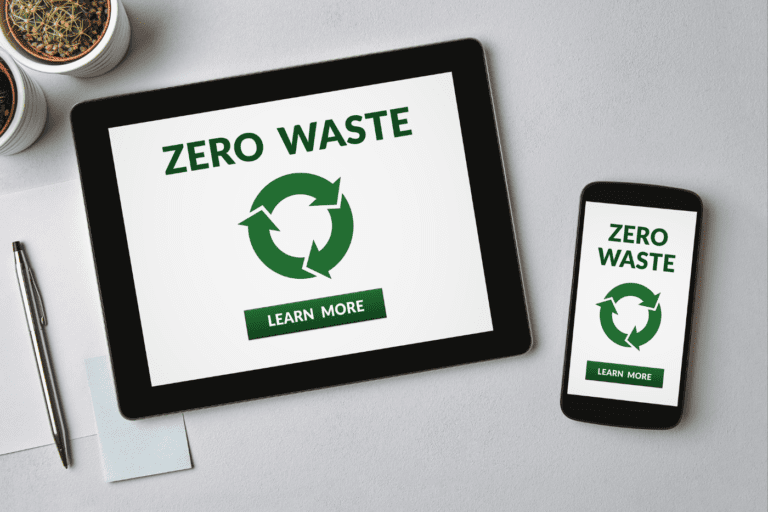Are you a fashion enthusiast who’s passionate about your wardrobe but concerned about the planet? Do you ever wonder about the environmental footprint of the clothes you wear?
In a world where the fashion industry plays a significant role in environmental degradation, understanding the consequences of synthetic fabrics is the first step toward change.
This guide will delve into the hidden costs of your favorite garments, providing insights and solutions that empower you to make informed and sustainable fashion choices
The Most Used Synthetic Fabrics in Fast Fashion
Polyester
Think of that trendy H&M dress or the Zara blouse you love. Chances are, they contain polyester. This synthetic fabric is a fast fashion favorite because it’s affordable and versatile.
However, its production is no friend to the environment. Imagine the energy consumed in making polyester and the microplastic pollution it contributes to when your clothes go through the wash.
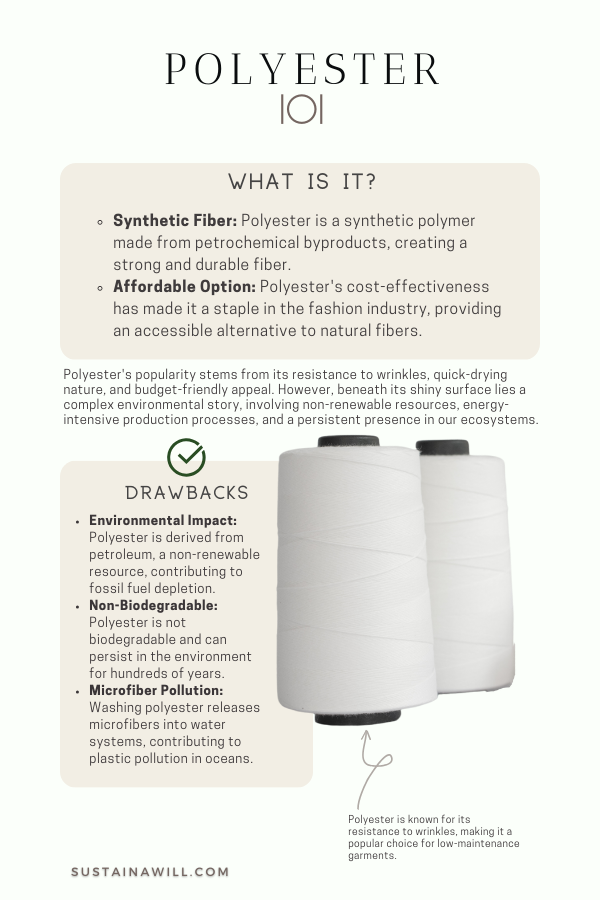
Nylon
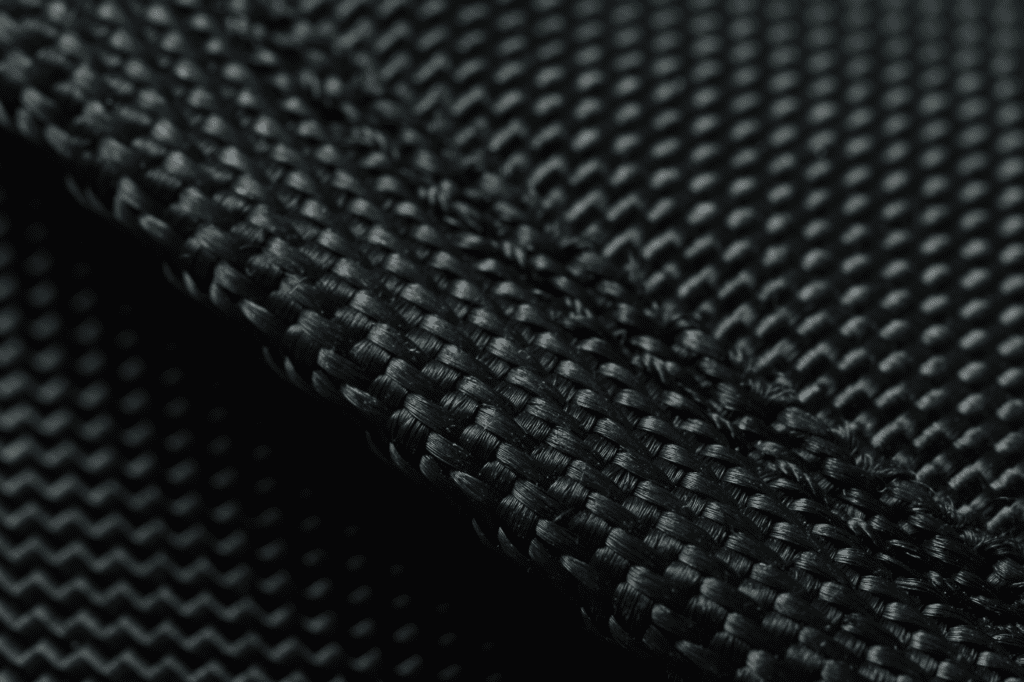
Forever 21 and Shein lovers, here’s a common thread: nylon. This fabric’s stretchability and durability make it a go-to choice for these brands.
But there’s a hidden cost. Nylon production releases nitrous oxide, a greenhouse gas much more potent than carbon dioxide. It’s a contributor to environmental harm you might not see.
Spandex (Elastane)

ASOS and Boohoo fans, you’ve probably encountered spandex in your favorite figure-hugging outfits.
While it provides that perfect fit, its manufacturing is resource-intensive, and it may involve the use of potentially harmful chemicals. It’s a stretch for both your clothes and the environment.
Acrylic
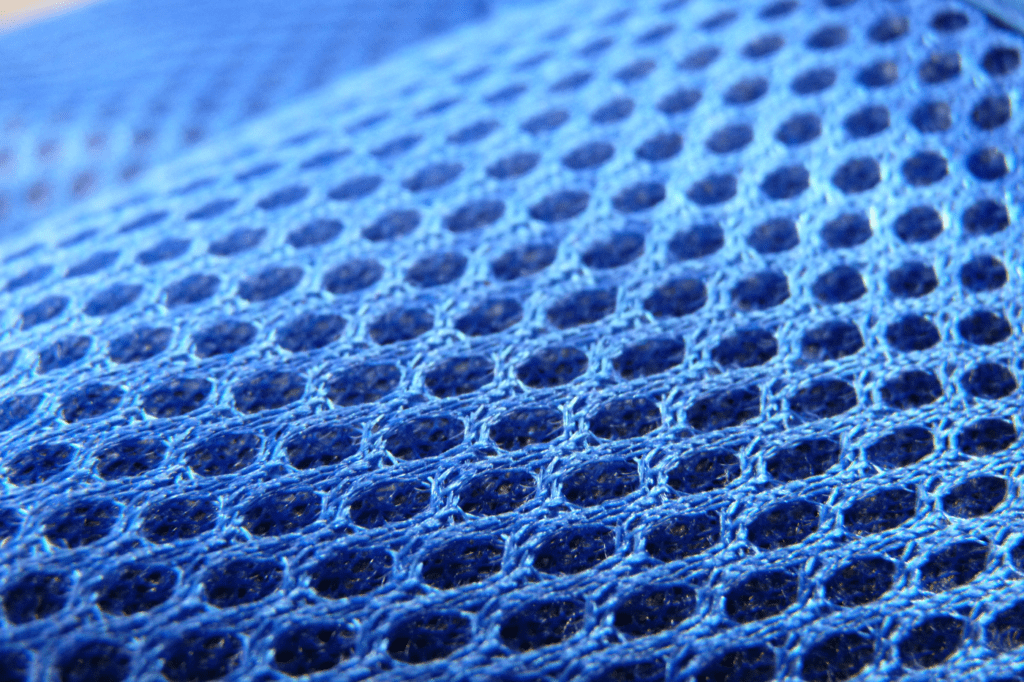
Love that cozy look from Primark or Fashion Nova? It’s often thanks to acrylic.
But acrylic comes from fossil fuels, and those beautiful, soft fibers can turn into environmental trouble when they release microplastics into the environment during your laundry.
And then we have Rayon, read more about this versatile fabric here: RAYON FABRIC EXPLAINED: HOW SUSTAINABLE IS IT REALLY?
The Environmental Impact of Each Synthetic Fabric
- Polyester: Producing polyester requires vast amounts of energy and emits greenhouse gases. When you wash your polyester pieces, they shed microplastics that threaten aquatic ecosystems. That lovely dress may come with hidden environmental costs.
- Nylon: The production of nylon releases nitrous oxide, a potent greenhouse gas. This not-so-friendly gas has a warming potential hundreds of times greater than carbon dioxide. The very fabric that makes your activewear stretchy could be stretching the Earth’s limits.
- Spandex (Elastane): That comfy, stretchy spandex involves some not-so-comfy processes. Manufacturing it often requires energy-intensive procedures and the use of chemicals that aren’t kind to the environment. Your flexible outfit might not be so flexible with its eco-friendliness.
- Acrylic: Acrylic, with its wool-like appearance, is often derived from fossil fuels. When you toss your acrylic sweater in the wash, it releases microplastics that can harm marine life and water bodies. That cozy look can have uncomfortable consequences.
Understanding the environmental impact of these synthetic fabrics is the first step in making more sustainable fashion choices. As we delve deeper into fashion’s guilty secret, we’ll explore alternative materials and brands that prioritize eco-conscious practices. 🌍
Microplastics and Water Pollution: Synthetic Fabrics’ Subtle Threat

It’s time to unravel a not-so-visible but critical environmental concern related to synthetic fabrics: microplastics and water pollution.
- Microplastic Generation: Synthetic fabrics, like those beloved polyester blends, silently shed microplastic particles into our environment during production, wear, and washing. These tiny plastic bits are practically invisible but highly concerning.
- Environmental Impact: These microplastics end up in our rivers, oceans, and aquatic ecosystems. They pose a significant threat to marine life and ecosystems, as well as our planet’s health. It’s a subtle yet potent form of pollution.
- Human Health Concerns: What goes around comes around. Microplastics, once in the environment, can re-enter the food chain and our water sources. This raises questions about potential health impacts that are still being studied.
- Mitigating Microplastics: Don’t worry; it’s not all doom and gloom. Researchers and innovative brands are exploring solutions like microplastic-capturing filters in washing machines and, importantly, sustainable fabric alternatives.
- Consumer Actions: Yes, you can make a difference! Consider using microfiber-catching laundry bags to trap those pesky microplastics and support brands that are actively working on solutions to reduce microplastic pollution.
Being aware of this hidden threat helps us all play our part in combating microplastic pollution and safeguarding our environment. It’s about taking small, meaningful steps for a cleaner, healthier planet. 🌊
Synthetic Fabrics and Landfill Overflow: A Growing Crisis
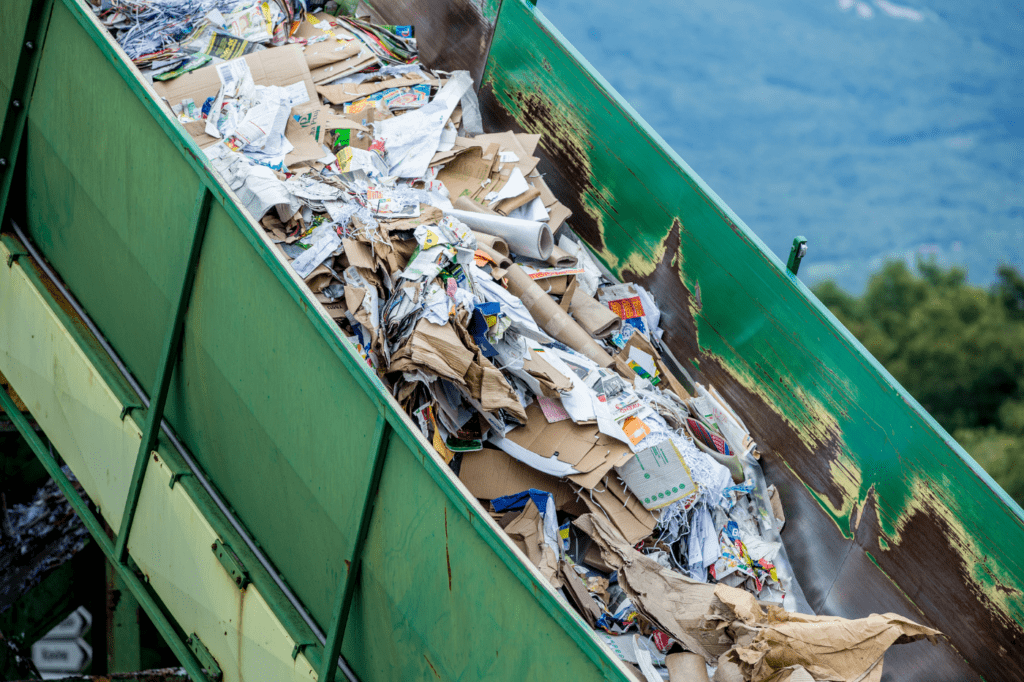
Let’s dive into another pressing concern within the realm of synthetic fabrics: their contribution to the fashion-related landfill crisis. This is a hidden issue that deserves our attention:
- A Mounting Crisis: As we embrace fast fashion and synthetic fabrics, we’re witnessing a growing crisis in our landfills. Synthetic garments take a long time to decompose and are often discarded after minimal use.
- Non-Biodegradable Nature: Synthetic fabrics like polyester, nylon, and acrylic are non-biodegradable, which means they don’t break down naturally. This leads to overcrowded landfills and extended environmental stress.
- Chemical Concerns: In addition to their slow decomposition, synthetic fabrics can release harmful chemicals when exposed to landfill conditions, further impacting the environment.
- The Slow Breakdown: Did you know that it can take hundreds of years for synthetic fabrics to break down in landfills? This prolonged presence poses a significant challenge for waste management.
- A Call to Action: The good news is that as consumers, we have the power to reduce this crisis. By supporting sustainable fashion choices, upcycling, and recycling, we can curb the overflow of landfills with synthetic fabric waste.
Understanding the impact of synthetic fabrics on landfills is the first step toward making more informed choices and collectively addressing this growing crisis. Let’s work together for a cleaner, greener future! 🌿👚
Can Synthetic Fabrics Be Sustainable?

Synthetic fabrics have long been associated with environmental issues, but can they make a U-turn and become eco-friendly? Let’s dive into the efforts to make synthetic fabrics more environmentally friendly:
Recycled Synthetic Fabrics
Some forward-thinking brands are turning to recycled synthetic fibers, reducing the demand for new production. By giving new life to old materials, they contribute to a circular economy.
- Econyl: This regenerated nylon is made from discarded materials like old fishing nets and fabric scraps.
- rPET (Recycled Polyester): Brands like Patagonia use recycled PET bottles to create sustainable polyester fabrics.
- Q-NOVA: A recycled nylon fiber made from pre-consumer waste, reducing the need for new nylon production.
Eco-Conscious Production Methods
Innovations in production techniques are minimizing the environmental impact of synthetic fabrics. This includes reducing water and energy usage and emissions.
- Waterless Dyeing: Techniques like AirDye reduce water consumption in fabric dyeing processes.
- Closed-Loop Systems: Some manufacturers employ closed-loop systems for solvent and chemical reuse, such as the one used in Tencel production.
- Energy-Efficient Processes: Innovations like the “Spinning Toward Sustainability” program by Lenzing focus on reducing energy use in fiber production.
Biodegradable Synthetics
Scientists are working on developing biodegradable synthetic fabrics that won’t linger in landfills for centuries. These materials break down more quickly, posing less harm to the environment.
- Piñatex: Made from pineapple leaf fibers, Piñatex is biodegradable and used for clothing, bags, and accessories.
- Mushroom Leather (Mycelium): Mycelium-based leather alternatives are entirely biodegradable.
- Synthetic Spider Silk: Biodegradable synthetic spider silk fabrics are being developed for various applications.
Sustainable Blends
Blending synthetic fibers with natural ones like organic cotton can improve the sustainability of fabrics. This approach combines the benefits of synthetics with the eco-friendliness of natural fibers.
- Tencel Blend: Combining Tencel with synthetic fibers like spandex creates stretchy, sustainable fabrics.
- Recycled Polyester/Cotton Blend: These blends offer the benefits of recycled polyester with the comfort of cotton.
- Hemp/Synthetic Blend: Hemp blends with synthetic fibers enhance durability while reducing the environmental impact.
Eco-Certifications
Look for synthetic fabrics that have obtained eco-certifications, such as OEKO-TEX or Global Recycled Standard. These certifications ensure a certain level of sustainability and safety in the fabric’s production.
- OEKO-TEX Standard 100: This certification ensures that synthetic fabrics meet safety and sustainability criteria in their production.
- Global Recycled Standard (GRS): GRS-certified fabrics contain a minimum of 20% recycled content, encouraging responsible material sourcing.
- bluesign® System Partner: Brands partnering with bluesign® commit to environmentally responsible textile production.
The fashion industry is evolving, and so are synthetic fabrics. While they may not be perfect, ongoing efforts to make them more sustainable offer hope for a fashion future that’s kinder to the planet.
The Rise of Fast Fashion: Synthetic Fabrics’ Silent Partner

Fast fashion and synthetic fabrics often go hand in hand, shaping our clothing choices and the industry itself. Let’s delve into this partnership and explore its implications:
Are Fast Fashion and Synthetic Fabrics Inseparable?
Defining Fast Fashion
Fast fashion refers to the rapid production and distribution of affordable clothing inspired by current fashion trends. It often involves quick turnovers of styles, low prices, and garments made from inexpensive materials, including synthetic fabrics.
The inseparability of Fast Fashion and Synthetics
Fast fashion has traditionally relied on synthetic fabrics due to their low cost, durability, and versatility. The affordability and rapid production of synthetic garments align with the core principles of fast fashion.
- Mass Production: Fast fashion brands produce large quantities of clothing quickly, and synthetic fabrics offer affordability and versatility to meet this demand.
- Trend Cycles: The rapid turnover of fashion trends encourages the use of synthetic fabrics, which can mimic the look of natural materials at lower costs.
- Disposable Culture: Fast fashion’s “wear it once” mentality aligns with the durability and cost-effectiveness of synthetic fabrics.
Can Fast Fashion Embrace Sustainable Materials?
Efforts to Change
Some fast fashion brands are beginning to incorporate sustainable materials, including natural fibers and eco-friendly synthetics, into their collections. These materials aim to reduce the environmental impact of clothing production.
- H&M: H&M introduced its Conscious Collection, featuring garments made from sustainable materials, including organic cotton and Tencel, a more environmentally friendly synthetic fiber.
- Zara: Zara launched its “Join Life” collection, which includes clothing items made from sustainable fabrics like organic cotton, recycled wool, and Tencel.
- ASOS: ASOS Design offers a range of sustainable options, such as clothing made from recycled polyester and eco-friendly materials, providing more sustainable choices for consumers.
- Gap: Gap’s commitment to sustainable fashion includes using sustainable materials in its clothing lines, such as Tencel, organic cotton, and recycled fibers.
Challenges Ahead
While change is possible, achieving a fully sustainable fast fashion model remains challenging. The fast fashion industry’s foundation of quick turnovers and low prices may require a fundamental shift in the way we approach fashion.
What Are the Sustainable Alternatives to Synthetic Fabrics?
If you’re eager to make more sustainable fashion choices, here’s your guide to discovering eco-friendly fabric alternatives in the world of fashion:
- Organic Cotton: Cultivated without synthetic pesticides and genetically modified seeds, organic cotton offers a cleaner and more sustainable choice.
- Hemp: Known for its durability, hemp is a rapidly renewable resource that requires minimal water and no synthetic chemicals.
- Tencel (Lyocell): Produced from sustainably sourced wood pulp, Tencel is prized for its eco-friendly closed-loop manufacturing process.
- Bamboo: This fast-growing plant provides a soft and breathable fabric option that’s naturally biodegradable.
- Recycled Fabrics: Fabrics made from recycled materials, such as PET bottles or discarded clothing, reduce waste and energy use.
- Hemp/Silk Blends: Blending silk with hemp creates a luxurious yet sustainable fabric option for elegant pieces.
- Wool: When ethically sourced and produced, wool is a renewable and biodegradable choice.
- Linen: Made from the flax plant, linen is highly sustainable, as it grows quickly and requires minimal water.
- Piñatex: Derived from pineapple leaf fibers, Piñatex is a vegan leather alternative that’s biodegradable and eco-conscious.
- Mycelium Leather: Grown from fungi, mycelium leather is a biodegradable alternative to traditional leather.
- Recycled Denim: Repurposing old denim jeans into new fabric not only conserves resources but also adds character to your clothing.
Sustainable fashion isn’t just a trend; it’s a growing movement. By exploring these alternatives to synthetic fabrics, you can make stylish and eco-friendly choices that align with your values and help reduce fashion’s environmental impact. 🌿👗
FAQs: Everything You Wondered About Synthetic Fabrics
What are synthetic fabrics?
Synthetic fabrics are human-made textiles produced using chemical processes rather than natural fibers. Common examples include polyester, nylon, and acrylic.
Why are synthetic fabrics popular in the fashion industry?
Synthetic fabrics are often chosen for their durability, affordability, and versatility. They can mimic the qualities of natural fibers and offer unique properties like moisture-wicking and stretch.
What is the environmental impact of synthetic fabrics?
The production of synthetic fabrics can be resource-intensive, contributing to energy consumption and emissions. Additionally, microplastic shedding during washing poses a pollution risk to water bodies.
Are there sustainable alternatives to synthetic fabrics?
Yes, sustainable alternatives like organic cotton, Tencel, and hemp offer eco-friendly options. Additionally, recycled synthetics and innovative bio-based materials are emerging.
How can the fashion industry reduce the environmental impact of synthetic fabrics?
The fashion industry can promote material innovation, transparency, recycling, emissions reduction, and eco-friendly practices to mitigate the impact of synthetic fabrics.
What can consumers do to support sustainable fashion in relation to synthetic fabrics?
Consumers can educate themselves, choose sustainable brands, reduce consumption, repair and upcycle clothing, recycle responsibly, and advocate for sustainable practices in the industry.
Are there eco-friendly dyes and finishes for synthetic fabrics?
Yes, sustainable dyeing and finishing methods, such as waterless dyeing and low-impact dyes, are being adopted by some brands to reduce the environmental impact of synthetic fabrics.
What certifications should I look for when buying synthetic fabrics?
Look for certifications like OEKO-TEX, Global Recycled Standard (GRS), and bluesign® that ensure certain sustainability and safety standards in synthetic fabric production.
Can synthetic fabrics be recycled or upcycled?
Some synthetic fabrics can be recycled or upcycled, but these processes are still emerging and may vary depending on the fabric type.
How can I dispose of old synthetic fabrics responsibly?
To dispose of old synthetic fabrics responsibly, consider participating in clothing recycling programs, donating clothing, or upcycling items. Avoid sending them to landfills.
What is the role of microplastics in synthetic fabrics?
Microplastics, tiny plastic particles shed during washing, are a concern associated with synthetic fabrics. They can enter water bodies, impacting aquatic life and ecosystems.
Are there regulations in place to address the environmental impact of synthetic fabrics?
Some regions and countries have introduced regulations and standards to address the environmental impact of textiles, including those made from synthetic fabrics.
Understanding the environmental implications of synthetic fabrics and the efforts to mitigate their impact is crucial for making informed fashion choices. 🌿👕
Conclusion: Embracing Your Role in a Greener Fashion Future
It’s not just the fashion industry’s responsibility; it’s ours as well. Our choices as consumers hold the power to steer the fashion industry towards a more sustainable and environmentally responsible future.
As you explore the world of fashion, keep in mind the environmental impact of your decisions. Educate yourself, support brands committed to sustainability, and reduce waste by making conscious choices. By taking responsibility for our fashion choices, we can collectively shape a greener future for the industry.
The fashion landscape is changing, and it’s up to each of us to play a part in this transformation. Let’s embrace our role and make a difference in the fashion world, where style and sustainability can coexist. 🌎👗💚







